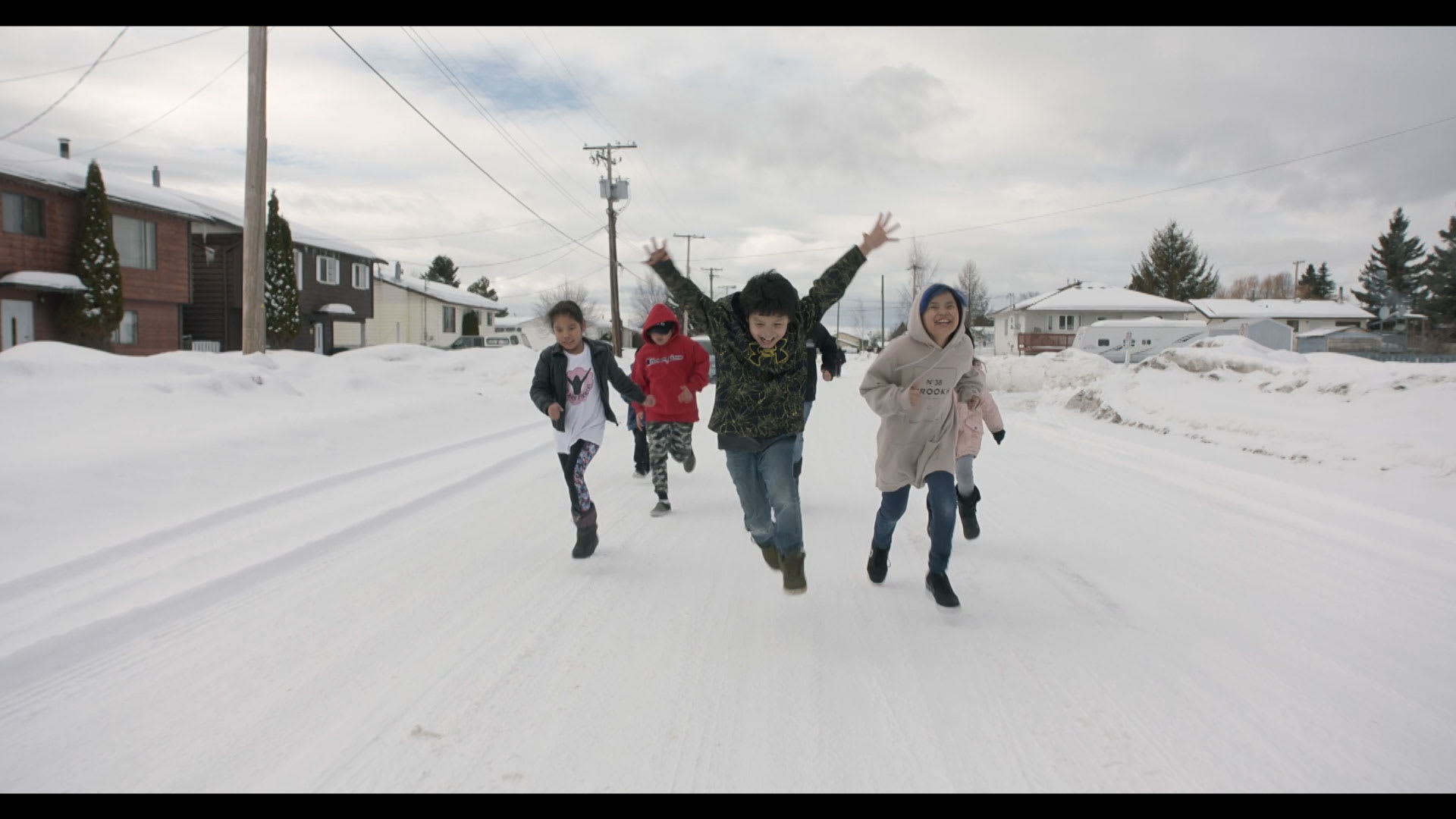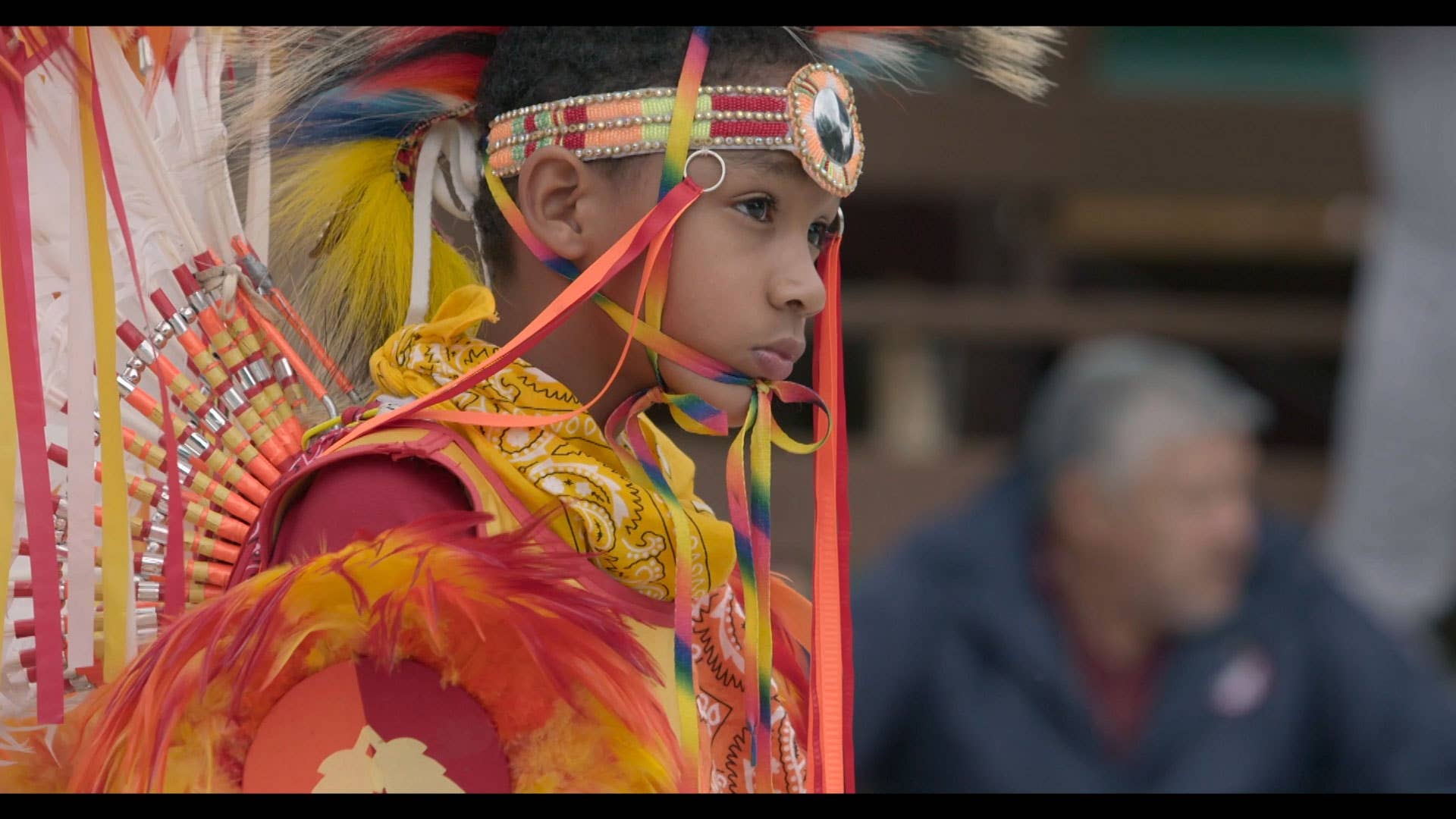
September 30 marks the first National Day for Truth and Reconciliation in Canada. Long overdue, this statutory holiday is meant for the country to reckon with its atrocious history of mistreatment of Indigenous peoples and the lasting intergenerational trauma of the residential school system. For Indigenous communities across the nation, such harsh realities are far from news—they’ve been suffering at the hands of the government since Canada’s conception, and continue to do so through unjust laws, neglect, and systematic discrimination. New documentary For Love highlights this, but also shows that hope is on the horizon, and that the beauty of Indigenous cultures across the country has persevered against tyranny.
Directed by Matt Smiley and produced by Mary Teegee, the film shines a light on how Canada’s child welfare system has hurt Indigenous communities. It debuts today via a private ceremony and screening at the Vancouver Convention Centre to mark Truth and Reconciliation Day. Smiley and Teegee previously worked together on Highway of Tears, which focused on missing and murdered Indigenous women in British Columbia.
Narrated by Shania Twain, For Love highlights the impacts of residential schools and colonization on Indigenous communities across Canada. Yet the film also shows just how resilient these communities have been, and proves that their plight will not define their culture—but that the richness of who they are will.
Complex caught up with Smiley and Teegee to discuss Canada’s current political landscape, the future of Indigenous communities, and what went into making such an impactful film.
Now, and always, exposing these stories is necessary for change and positive forward motion. Your film debuts September 30, the first National Day for Truth and Reconciliation in Canada. Mary, can you expand more about what this day represents for Indigenous communities?
Mary Teegee: It’s a day just to acknowledge the atrocities that occurred in the past. But what’s really important is to understand that the impacts of residential schools and colonization are factors that still affect the wellness of our people. There is not one Indigenous person across Canada that has not been impacted by residential schools and colonization. Not one. Within our communities we have higher rates of suicide, we have poorer health outcomes, we, of course, have higher rates of children in foster care. And this all goes back to the breakdown of family, the weakening of our culture. Each individual [Indigenous person] either went to a residential school, had parents [or grandparents] that went to a residential school. Because of the grief that we have, and I would call it malignant grief, and the multi-general impacts of residential schools, we see everyday our people self-medicating and trying to lessen their trauma.
You both worked on Highway of Tears together, and this is your second collaboration together on a project about Indigenous stories and rights. What has it been like working together?
Teegee: I think it’s really important to note that working with Matt for the second time was a deliberate decision on my part. Matt really understands and empathizes with the plight of our people, but also understands the resilience and the strength of our people. I wanted somebody that was not Indigenous, actually, to see the film through their eyes. As you know, being an Indigenous woman, being a matriarch—I’m quite a strong woman, and I think, OK, people should know this. And Matt would remind me—no, Mary, your people know that and maybe a few Canadians, but for the most part people [as a whole] don’t understand. So it was looking at the film as an educational piece, but also to raise awareness. Matt was brilliant to bring that other voice to say that “not everybody understands, so maybe we need to take the film in this direction.”
“How is a first world country like Canada a place where we actually had to take the government to court for discrimination against Indigenous children? It’s ridiculous that we actually had to do that.”
Matt, as someone that’s non-Indigenous, what has your experience been like creating this project, as well as Highway of Tears?
Matt Smiley: I think with Highway of Tears, I didn’t really know exactly what I was getting into, and that spring-boarded into a really big initiative to really start raising voices. There was so much pain within that particular project that was really felt by so many people across the country, not just British Columbia. With this particular project, when Mary and I really started talking about it, on a two-fold level, what I loved was the title For Love, and for her it was “for love the children.” [We wanted to] show everything that’s positive that’s happening, of course not shying away from the past history that we do detail in the film, but the emphasis was to shine a light on the children and the culture, and this revival of culture. Especially with Bill-C92, it showcases that new jurisdictional shift of having control over their own children, and just trying to let that resonate on an international platform.

Mary, the importance of the work you’ve done can’t be understated; these are stories that are vital for all human beings to learn about and fully comprehend. There’s a lot more work to be done, especially in the government sector. What more do you believe needs to be done in the immediate future?
Teegee: I believe that every child, regardless of race and ethnicity, should be able to live up to their full potential. When you look at the baseline, every child should have clean running water, every child should be nurtured, every child should be connected to their family, should have clothes and food. Basic human necessities. So we have to ask, how is a first world country like Canada a place where we actually had to take the government to court for discrimination against Indigenous children? It’s ridiculous that we actually had to do that. So here we are, we’re still in court with Canada, we’re still proceeding and there’s still discrimination against Indigenous children, the most vulnerable people in Canada.
What needs to happen is that [the government] really needs to listen, and I think that’s what reconciliation is. Cindy Blackstock always says this: Reconciliation is never having to say sorry twice. We’re at this place where we can make fundamental change, and so we have to work with the governments. We have to change policies and increase funding. It costs more money to put children in care than to prevent children from going into care. Across every social sector we know that to be true—you invest now so you don’t have to intervene later, which costs more. It’s a humanitarian crisis, internationally. We already have the United Nations Declaration of Rights of Indigenous People, Canada is making movements adopting this. So what do those articles mean? At the very core, it’s that we have the right to be Indigenous and to benefit from the resources of our territories, and every government policy should be reflecting that.
What can we, as viewers, do to bring more awareness and change to the issue of Indigenous children in the foster care system, and the injustices of missing and murdered ingenious girls and women?
Teegee: We have to look at who our allies are, and partner with them. I’ve been asked this question a lot, especially after the unmarked graves were found. I will tell you that it’s moved me like it never has before. I’ve went through discrimination [my whole life], banging my head against the wall and my hand against the table trying to make a change. I lost friends over the years because of their ignorance , but then all of the sudden there was a shift. There were people finally saying, “What can be done?” and donating to [Indigenous foundations]. When you put children in the mix, everyone wakes up. What people need to do is make demands to their MLAs to actually implement the 94 calls to action, and also implement the calls to justice that came out of the missing Indigenous women and girls inquiry. People need to lobby [for implementing] an act specifically for the missing and murdered Indigenous women act in Canada. If we have an act, it’s not just lip service, the act would provide funding and resources. But even just listening to Indigenous people, understanding their plight, and having more empathy when you see someone on the street and considering how we treat them.
“You see babies that have bad skin because of the water, and you witness poverty. But still, underneath all of that, you see the strength, the resilience, and the richness of the people.”
From the trailer of the film, we already see the immense richness of Indigenous culture across the country. Can you tell me more about what that was like to capture?
Smiley: First and foremost, it was such a privilege to be invited to go film in these communities, and share their stories and their culture and their heritage, and really see them open up their arms not just to the communities but to the children, and to show all the amazing work they’re doing across the country. Mary, on a daily basis, has very much done that, but to shadow her and follow along and see some of these initiatives coming together. [An example] would be seeing a young kid having some problems, but that they’ve been able to take care of them as a community. It’s seeing the community come together for a powwow. Even in communities that don’t have the same kind of resources as other communities, you have people being vocal about some of the needs and taking their own initiatives without the government. By taking [the kids] out onto the land, by really getting them connected to their culture, whether it’s through the music, drumming, or just teaching them the ways of the land they live on. Those things are not always readily available, but the more initiatives are made, and the more people understand in their heart what is needed to create young leaders of the future, is where a shift happens—and we will see a lot more culture come together.
Teegee: For me, the beauty of all the cultures that we saw, we saw that there’s commonalities that we have as Indigenous people, which I loved. But we also saw the differences and celebrated them. As beautiful as the people were, it just moved my soul, but we also see the impacts of residential schools and colonization in front of us. You see the poverty and you see the hurt and trauma. You see the injustices, the resources being taken, and you wonder how can this happen in a first world country? In some places, there were 20 people living in a single house; we couldn’t drink the water, we couldn’t take a shower for longer than two minutes. You see babies that have bad skin because of the water, and you witness poverty. But still, underneath all of that, you see the strength, the resilience, and the richness of the people. There’s nothing I think that I could ever experience that would come close to the making of this film. I can’t even express how beautiful, how glorious it was to see my people rise up.

While the film details the past horrors of injustices the Indigenous community has faced, its focus is described as how these communities are takingpower back and ensuring their voices are heard and changes are made. What kinds of inspiration did you both feel while making the film?
Smiley: There were so many people we got to interview from coast to coast, especially leaders on a community grassroots level, various people that are so resilient and have so much love in their hearts to take care of their community. One person [that comes to mind] in particular is Derrick Montour, who also serves on boards with Mary. To watch the beautiful work that they’re doing, even from the prenatal stage, to ensure that every family has the resources to tackle some of these generational issues. The big takeaway for me, across the country, was almost universal: whatever you do, think about the impact for several generations. I think it’s really telling that this is well known [in the community] and it’s a great time period for people to witness this beautiful culture, and the knowledge that it has.
Teegee: This film is for love of the children, but it’s also for hope. I see the strength of the individuals that we talked to. There were so many young children that we saw, the hope that they have, how strong they are. There was this young little guy, maybe 11 years old, who had been in various homes and now is with the Indigenous agency back east. And he is so thankful for every single thing he has, he just soaks up the culture, he is so wise. The way that he treats his younger sister. He was in a non-Indigenous foster home before, now in an Indigenous foster home with extended family. To see his strength and his beauty, and so firmly strongly Miꞌkmaq, nobody was going to take that way. That’s what I really loved to see, that no matter what, they were so proud to be Indigenous. That resilience was such an honour to witness.
What was it like working with Shania Twain?
Smiley: I think one of the most impressive things with Shania, and one of the things she understands about her own personal journey, is resilience. She has such a big, beautiful heart, and she was so touched by the culture. One of the things Mary and I mutually loved about her was that she spent a majority of her life before she was a star taking care of children. With the incentive that she’s had from her stardom and her career, she’s never let go of where she came from, and she’s always thankful for that. She’s been a great ally to give us a leap on an international level, because anywhere you go in the world people know Shania Twain. She’s always led with her heart and taken care of children to make sure that they didn’t go through some of the things that she did, that she inherently knows.
Teegee: When we first started this, I wanted a woman’s voice, because it’s about children. At the end of the day, we wanted it to be on an international scale. When we thought of Shania Twain, I thought, “Oh there’s no way we’re going to get her” because she’s huge, she has a Vegas residency coming up. But it came back to her, and for me, spiritually, I firmly believe that this was a decision that was led by the creator. Because she lent her voice to this film, and she’s getting her own voice back. Her strength and resilience really comes through in the film.

Is there anything else you’d like to add about the film?
Teegee: The reason we wanted this film shown on September 30th is because it is truly a good example of reconciliation. We collaborated with people at Indigenous Service Canada, we [proposed] the film, and we were given full artistic control, and we spoke about what the children needed to see, what the nation and community needed to see. I think this film is so appropriately being released on the first National Day of Truth and Reconciliation, because it is a symbol of reconciliation. But more importantly it’s a symbol for love and for hope. These children [in the film] will be adults, and I hope this film always reminds them of who they are, how strong they are, and where they belong.
Smiley: There’s a reason we shot it in every province and territory in Canada, and we’re looking forward to screening with them. Of course because of COVID we’ll have some kind of online component, and it will be used as an educational tool. We already have schools and universities that wanted to get behind the film because there’s a positive message. It doesn’t shy away from impacts of what happened, but there’s a point right now, a turning point. How do we empower? How do we teach people? And people can really rally behind children because they’re the most important resource we have to ensure a good future.
Thank you so much for taking the time to speak to us. This film is an important step in the right direction, and we all will benefit from educating ourselves with it while also being given a beautiful opportunity to relish in Indigenous cultures from across the nation. To end off, I’d like to ask if there are any resources you’d like to share for our readers to research or contribute to?
Teegee: The I Am a Witness movement. I am a board member, and the remarkable work done by our staff and board, led by the indomitable Cindy Blackstock can’t be understated. When we talk about what can we do, what can the government do, there is a plan; a very clear pathway to ending the injustices and the inequity that [Indigenous] children and families suffer. There’s plenty of resources on the I Am a Witness movement site, films, and educational tools.


